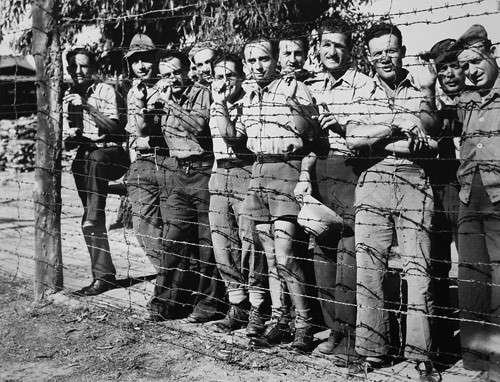Italian-Americans as Alien Enemies: Westchester Opera Star Ezio Pinza


 In 1766 jurist William Blackstone published his Commentaries on the Law of England in which he defined the term “enemy alien” as it was understood in common law. He confirmed that during a time of war “alien enemies have no rights, no privileges.” The Crown exercises absolute power. In a simple turn of phrase, the Oxford professor anticipated the agony of millions of migrants.
In 1766 jurist William Blackstone published his Commentaries on the Law of England in which he defined the term “enemy alien” as it was understood in common law. He confirmed that during a time of war “alien enemies have no rights, no privileges.” The Crown exercises absolute power. In a simple turn of phrase, the Oxford professor anticipated the agony of millions of migrants.
In 1798, anticipating hostilities with France, the United States created its own Alien Enemies Act which authorized the President to detain or deport natives of an enemy nation without a hearing. The law was enacted to prevent foreign sabotage in wartime, but could be (and has been) wielded against immigrants who displayed no signs of betrayal or disloyalty.

 Unchecked detention and deportation power implied the risks of abuse and rights violation, even in peacetime. But the Alien and Sedition Acts never came before the Supreme Court (SCOTUS), which didn’t have the power of judicial review until 1803.
Unchecked detention and deportation power implied the risks of abuse and rights violation, even in peacetime. But the Alien and Sedition Acts never came before the Supreme Court (SCOTUS), which didn’t have the power of judicial review until 1803.
Since the mid-20th century SCOTUS opinions have referred to the Acts over the years, in ways that lead most legal scholars to assume they would be found unconstitutional today.
In the important free speech case New York Times Co. v. Sullivan (1964), the Supreme Court declared that “Although the Sedition Act was never tested in this Court, the attack upon its validity has carried the day in the court of history.”
In Watts v. United States (1969) the Court concurred in a case about a threat against the President. Associate Justice William O. Douglas wrote: “The Alien and Sedition Laws constituted one of our sorriest chapters; and I had thought we had done with them forever… Suppression of speech as an effective police measure is an old, old device, outlawed by our Constitution.”
Although most modern historians also consider the Alien and Sedition Acts to have been a mistake, President Donald Trump said he would reinstate the Alien Enemies Act. He has begun detaining an unknown number of people offshore in an internment camp at Guantanamo Bay Naval Base in Cuba under the Act’s deportation clause.
Internment Camps
Before the outbreak of World War One, civilian internment had been used sporadically as a tactic in colonial wars, including against indigenous people in the American West. Many died of disease, malnourishment, or attempting to escape.

 In 1896, Spain established camps in Cuba in an attempt to quell guerrilla activities on the island. Lack of food and medical care meant that thousands died from disease or starvation. Five years later, the United States military briefly established similar camps in a brutal campaign against Philippine independence fighters.
In 1896, Spain established camps in Cuba in an attempt to quell guerrilla activities on the island. Lack of food and medical care meant that thousands died from disease or starvation. Five years later, the United States military briefly established similar camps in a brutal campaign against Philippine independence fighters.
During the Anglo-Boer War between 1900 and 1902, the British Army built more than a hundred camps to intern Afrikaner families and Black Africans. Field Marshal Horatio Herbert Kitchener made “internment” a byword for suffering. These camps held the seeds of the horrors they would be associated with some decades later, from sites of detention to factories of genocide.
The First World War was a watershed moment in the treatment of civilians in armed conflict. By the end of the war, concentration camps stretched across six continents. In a period of only four years of hostilities, mass detention of innocent civilians had become a legitimized practice on every corner of the earth.
Established in 1890, Ellis Island first served as a stopping point for immigrants who were processed and medically checked before starting their new lives on American soil. It was feared that new arrivals might spread infectious diseases and patients were isolated and treated until they recovered. Relatively few newcomers were held for political or security reasons.
Socio-political unrest in the United States during the 1910s and 1920s (strikes, anarchist bombings, anti-war demonstrations) prompted the Department of Justice to arrest hundreds of “suspect” aliens.
Ellis Island changed from an immigrant depot to an incarceration center. By the 1930s, it was used almost exclusively for detention and deportations; as many as 7,000 detainees and “internees” were held in captivity there during World War II.
Proclamation 2527
On June 10, 1940, Mussolini declared war with France and Britain. In reply, Winston Churchill ordered to “collar the lot.” By that time large numbers of Italian immigrants had settled in Britain and the community (especially in London) was well-established and integrated.
A wave of anti-Italian hysteria grasped the nation. Over 4,000 men were arrested, separated from their families and interned in camps across the country or shipped out to Australia and Canada.
Following the Japanese attack on the American naval base at Pearl Harbor on December 7, 1941, Franklin Roosevelt delivered this “Day of Infamy Speech.” Immediately afterwards, Congress declared war against members of the Tripartite Pact (Japan, Germany and Italy).

 The next day the President issued Proclamation 2527 by which some 600,000 undocumented Italians residing in the United States were declared to be “Enemy Aliens.” Local authorities took immediate measures to identify and control their location and movement.
The next day the President issued Proclamation 2527 by which some 600,000 undocumented Italians residing in the United States were declared to be “Enemy Aliens.” Local authorities took immediate measures to identify and control their location and movement.
Mandated to register and carry identification papers, they were put on curfew, subjected to travel restrictions and forbidden to possess cameras, weapons or short-wave radios. The deportation frenzy started there and then.
Thousands of Italians were banned from “coastal zones” and forced out of their homes. East and West Coast fishermen lost their vessels and livelihood. More than 1,600 arrests were made from December 1941 through to June 1942 and over 300 citizens were incarcerated in camps in Oklahoma, Montana and Texas.
These actions created a hostile atmosphere of harassment which had a demoralizing impact on long established Italian-American communities, schools and organizations.
Immigrants from Italy had endured prejudice for decades by the time the order was drafted. Pseudo-scientists and populists of the 1920s had spread the notion that Italians were a “separate” race from Anglo-Americans. Racial stereotyping served as pretext for deportation programmes.
Despite this discriminatory treatment, many young men felt intense pressure to prove their patriotism and loyalty, enlisting in the military at a higher rate those of other backgrounds. Thousands of Italian-American soldiers made the ultimate sacrifice in defense of the United States.
La Scala, Milan
In New York City and across the country, FBI agents began to arrest Italian immigrants in the days immediately following the declaration of war. One of the victims was the world’s greatest operatic singers at the time. He was forcefully removed from his Mamaroneck home in Westchester County, NY.
Born in Rome on May 18, 1892, Fortunato Ezio Pinza (1892-1957) was his parents’ seventh child, but only the first to survive infancy. He grew up in Ravenna and intended to become an engineer.

 Having recognized the natural beauty of the boy’s singing voice, his father tried to encourage him to study music at the prestigious Liceo Musicale in nearby Bologna. The legendary Gioachino Rossini (1792-1868) had once been a pupil at the school and later acted as its director.
Having recognized the natural beauty of the boy’s singing voice, his father tried to encourage him to study music at the prestigious Liceo Musicale in nearby Bologna. The legendary Gioachino Rossini (1792-1868) had once been a pupil at the school and later acted as its director.
Ezio had other plans. At the age of eighteen he signed up as a professional cyclist. His best result was a fourteenth place in Bologna’s 1909 Giro dell’Emilia and he soon realized that there was no future for him in cycling. Pinza quit after two years, but he credited bike racing (he was categorized as a “climber”) for developing his prodigious lung capacity.
Having secured a scholarship which he supplemented by working as a handyman, he began his studies in Milan and made his operatic debut in 1914 in Vincenzo Bellini’s Norma in Cremona, performing the role of Oroveso. Shortly after that momentous event his career and studies were interrupted by war and the duty of military service.
After the war, Pinza tried to resume his fledgling opera career in Rome. In 1920 he appeared as King Mark in the Italian version of Richard Wagner’s Tristan und Isolde. His performance drew the attention of conductor Arturo Toscanini (1867-1957) who offered him a three-year contract at La Scala in Milan.
His career took off in 1922 after starring in the role of the monk Pimen in Boris Gudonov, Modest Mussorgsky’s masterpiece and only completed opera.
Metropolitan Opera, Manhattan
Impresario Giulio Gatti-Casazza (1869-1940) had managed La Scala from 1898 to 1908 before moving to New York City. He was general manager of the Metropolitan Opera until 1935 and cemented its reputation
of creative versatility. He persuaded the gifted Toscanini to join him. The latter became the Metropolitan’s principal conductor, setting a standard of excellence not seen or heard in the United States previously.
In 1926, after three years in Milan, Pinza was engaged by Gatti-Casazza, appearing first as the Pontifex Maximus in Gaspare Spontini’s La vestale with the formidable American soprano Rosa Ponselle (real name: Rosa Ponzillo) in the title role. One critic hailed Pinza as a “majestic figure on the stage [and] a basso of superb sonority.” For the next two decades he would reign as America’s leading operatic bass singer.

 Pinza’s name is above all associated with the role of Don Giovanni in Mozart’s opera of that name. Absent from the Met’s repertory between 1908 and 1929, the work was brought back to the stage in a new production by the Viennese Art Deco architect and designer Joseph Urban.
Pinza’s name is above all associated with the role of Don Giovanni in Mozart’s opera of that name. Absent from the Met’s repertory between 1908 and 1929, the work was brought back to the stage in a new production by the Viennese Art Deco architect and designer Joseph Urban.
Dressed in a golden costume, Ezio Pinza delivered his most lauded portrayal, one that he would continue to interpret until his resignation from the opera house two decades later.
Just like Mozart’s character of Don Giovanni, a notorious playboy who forges the path of his own destruction, Pinza was a serial womanizer. With his wavy black hair and signature fedora, he made a stylish appearance and carried on (notorious) affairs with a number of celebrated opera stars of his era. Rosa Ponselle called him a salacious “pig” who tried to seduce as many women as he could.
His liaison with the German soprano Elisabeth Rethberg led to a divorce from his wife Augusta Cassinelli. An affair with Gretel Walter, the daughter of Bruno Walter who had conducted Pinza’s triumphant performance of Don Giovanni at the Salzburg Festival, turned into tragedy. In Berlin on August 21, 1939, her jealous husband shot the diva in a furious rage and then killed himself.
Between Ellis Island & Broadway
Life settled down in the early 1940s after Pinza married American-born Doris Leak and settled in the Westchester suburbs with their infant daughter. But on March 13, 1942, two FBI agents barged into
his house through an open door and arrested him “in the name of the President of the United States.”
He was taken to Manhattan’s Foley Square courthouse, fingerprinted and interrogated before being hauled off to an internment camp on Ellis Island, one of many “enemy aliens” locked up by federal authorities.
The news of his arrest, four months shy of obtaining US citizenship, was front page news the following day. The authorities claimed without providing any evidence that Pinza had been on friendly terms with Benito Mussolini. Who needs prove whem there are headlines at stake?
His internment was a personal triumph for Edgar J. Hoover and his program of hunting down potential traitors – “FBI’s Been Watching Him: Pinza, Met’s Basso, Jailed as Duce’s Pal,” the Washington
News screamed.
Ezio’s wife claimed in a statement released shortly after his arrest that Pinza had never met the dictator. He was not informed about the substance of charges against him, nor was he allowed an attorney.
Norman Cordon, a rival bass singer at the Metropolitan Opera, boasted privately that he had given notice to the FBI that Ezio was a Fascist sympathizer.
Pinza was interned for eleven weeks on Ellis Island. He was released after pleas from novelist Thomas Mann, the 1929 German Nobel laureate, and Italian newspaper editor Carlo Tresca (both refugees
from Fascism) amongst others on condition that he reported weekly to “a reliable US citizen.” Ezio chose his physician.
The restrictions placed on Italian-Americans were finally lifted on Columbus Day at October 12, 1942. Those incarcerated in internment camps were set free after the surrender of Italy to the Allies in September 1943.

 Pinza retired from the Met in 1948 to move into musical theater. His physical appearance was as imposing as ever and the power of his voice undiminished. Together with Mary Martin he starred in the original cast of Rodgers and Hammerstein’s highly rated South Pacific, performing the role of the French planter Emile de Becque.
Pinza retired from the Met in 1948 to move into musical theater. His physical appearance was as imposing as ever and the power of his voice undiminished. Together with Mary Martin he starred in the original cast of Rodgers and Hammerstein’s highly rated South Pacific, performing the role of the French planter Emile de Becque.
Premiering at Broadway’s Majestic Theatre on April 7, 1949, the show was an instant hit. Awarded the Pulitzer Prize for Drama (only the second musical to earn that distinction), it ran for 1,925 performances until January 1954.
Among camp survivors post-traumatic stress disorder was a long-term psychiatric consequence. Pinza’s imprisonment when he was 50-years-old and at the apex of his career would haunt him for the rest of his life.
Although he had enjoyed 750 performances in fifty operas at the Met and experienced a highly successful stint on the Broadway stage, internment had undermined both his mental health and outlook on life. He suffered from bouts of severe depression.
On May 9, 1957, Ezio Pinza died of a stroke, shortly after completing his autobiography which was published a year later.
Read more about Italian-American history.
Illustrations, from above: Italian-Americans behind metal wire fencing at an American internment camp (National Italian American Foundation); William Russell Birch’s painting of the US Capitol, home of Congress and Supreme Court, ca. 1800; A multi-lingual notice from the Department of Justice for all “enemy aliens” to register at their nearest post offices (National Archives); Ezio Pinza with his signature fedora; Ezio Pinza as Don Giovanni in Mozart’s opera of that name, 1929 (Metropolitan Opera); and a newspaper advertisement for Mary Martin and Ezio Pinza in South Pacific, 1949, (Billy Rose Theatre Collection, NYPL).
Source link





